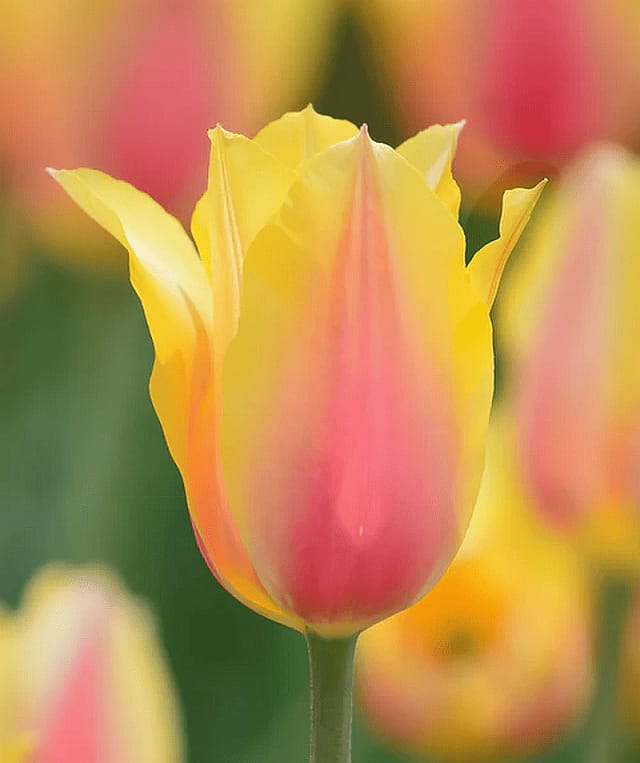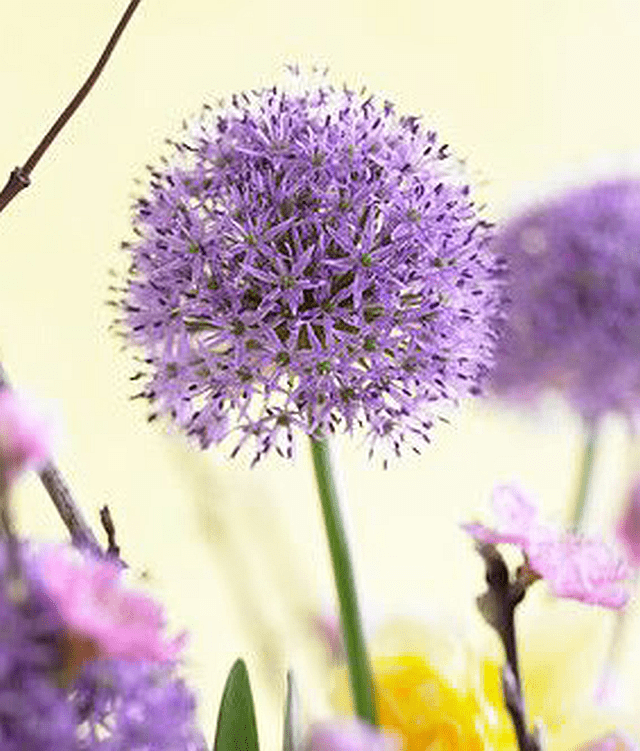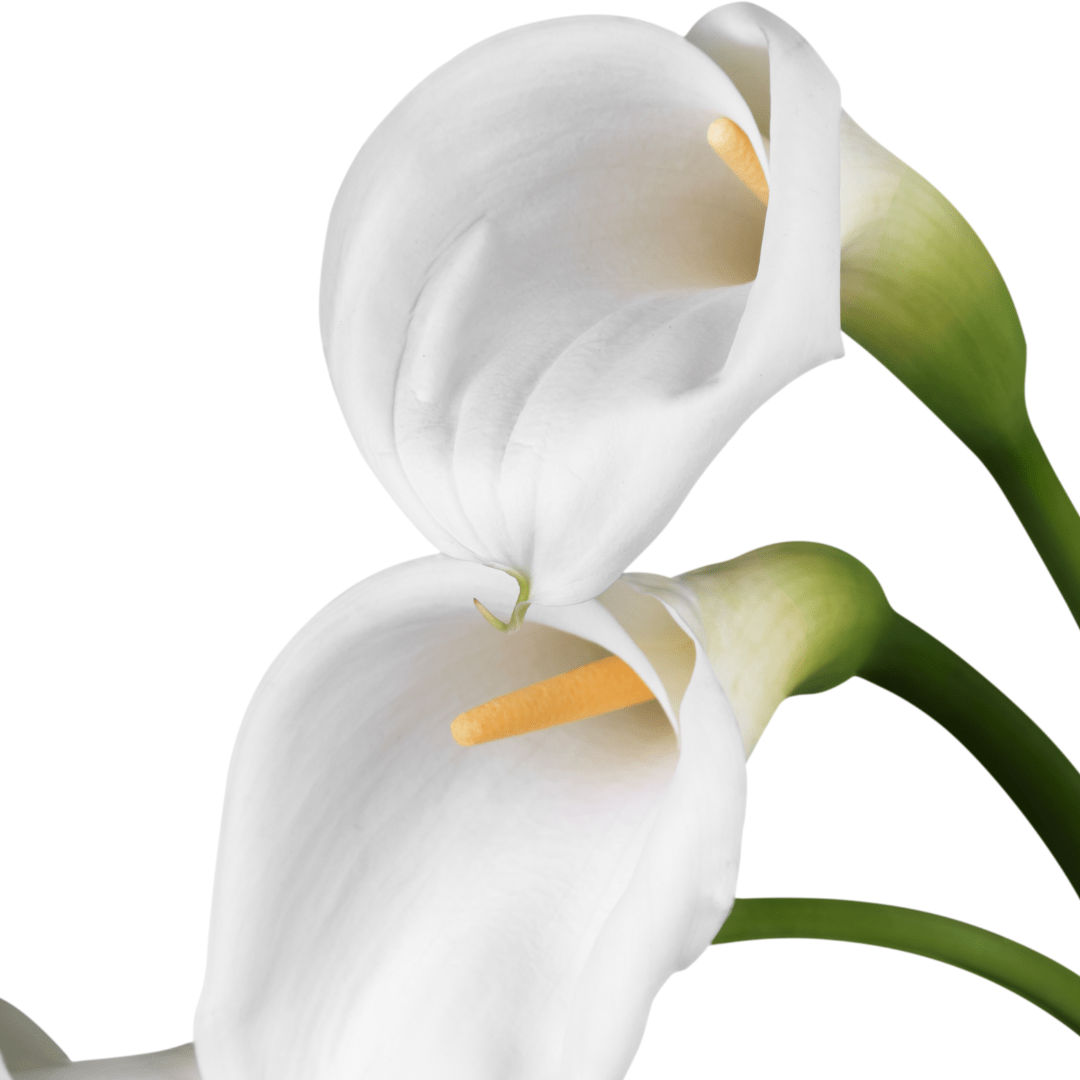This post may contain affiliate links. As an Amazon Associate we earn from qualifying purchases.
Fall bulbs bring spring and summer flowers. Get them in the ground soon so you don’t miss one color-filled moment.
As the days cool off (finally!), many of us start thinking about the fall garden. In the case of those of us who grow bulbs, those thoughts and dreams extend to spring, when our fall-planted bulbs erupt into a sea of amazing color.
Although there are many more bulbs that you can plant now for spring color, we put together this guide to 15 of the most popular.
By the way, we’re using the term “bulb” as a catch-all. In reality, some of the following plants grow from corms or even root divisions. If you’d like to learn more about the difference between bulbs, tubers, tuberous roots, rhizomes and corms, check out our Gardening Terms Demystified post.
Tulip (Tulipa spp.)

When it comes to fall bulbs, tulips top many gardeners’ must-have list. Tulips are one of the most iconic spring flowers, known for their vibrant colors and elegant shape. These bulbs are perennial, though they are often treated as annuals in some climates.
- USDA Hardiness Zones: 3-8
- Height and Spread: 6-24 inches tall and 4-6 inches wide
- Soil: Well-drained, sandy or loamy soil
- Sunlight: Full sun to partial shade
- Water: Moderate; keep soil moist but not waterlogged
- Planting Time: Late fall, after the first frost
- How to Plant: Plant bulbs 6-8 inches deep and 4-6 inches apart. Loosen the soil and mix in compost before planting.
- Fertilization: Fertilize at planting time and again in early spring with a 3-1-2 or 6-2-4 fertilizer.
- Bloom Time: 8 to 16 weeks after planting, depending on the variety.
- Pests and Diseases: Watch out for aphids, bulb rot, and tulip fire, a fungal disease. If you suspect tulip fire, immediately remove infected plants and don’t grow tulips in that spot again for at least three years.
- Pet Toxicity: Tulips are toxic to pets, particularly dogs and cats.

Allium (Allium spp.)
Alliums, with their globe-like flower heads, add a unique architectural element to the garden. These perennials are not only beautiful but also deer-resistant.
- USDA Hardiness Zones: 4-9
- Height and Spread: 12-48 inches tall and 6-12 inches wide
- Soil: Well-drained, fertile soil
- Sunlight: Full sun
- Water: Low to moderate; water sparingly after planting
- Planting Time: Mid to late fall
- How to Plant: Plant bulbs 4-6 inches deep and 6-8 inches apart. Amend the soil with compost if needed.
- Fertilization: Fertilize in early spring with a slow-release fertilizer.
- Bloom Time: 8-12 weeks after planting
- Pests and Diseases: Generally pest-free, but watch for onion thrips and root rot in poorly drained soil.
- Pet Toxicity: All parts of the plant are toxic to pets.

Bearded Iris (Iris germanica)
Bearded irises are beloved for their ruffled, colorful blooms and their ability to thrive in a variety of conditions.
- USDA Hardiness Zones: 3-9
- Height and Spread: 12-36 inches tall and 12-18 inches wide
- Soil: Well-drained, neutral to slightly acidic soil
- Sunlight: Full sun
- Water: Low to moderate; avoid overwatering
- Planting Time: Late summer to early fall
- How to Plant: Plant rhizomes just below the surface of the soil, spaced 12-18 inches apart. Ensure good air circulation around the plants.
- Fertilization: Fertilize in early spring and again after blooming with a bulb fertilizer. See our recommended product in the crocus section.
- Bloom Time: 12-16 weeks after planting
- Pests and Diseases: Watch for iris borers, slugs, and fungal diseases.
- Pet Toxicity: Toxic to pets if ingested.

Crocus (Crocus spp.)
Crocuses are some of the earliest bloomers in the spring, often pushing through the last snow to reveal their cheerful colors.
- USDA Hardiness Zones: 3-8
- Height and Spread: 2-6 inches tall and 2-4 inches wide
- Soil: Well-drained, sandy or gritty soil
- Sunlight: Full sun to partial shade
- Water: Low; water sparingly after planting
- Planting Time: Early to mid-fall
- How to Plant: Plant bulbs 3-4 inches deep and 2-3 inches apart. Work in some compost to improve soil fertility.
- Fertilization: Fertilize at the first sign of growth in spring, with a slow release bulb fertilizer. We recommend Espoma’s Bulb-tone.
- Bloom Time: 10-12 weeks after planting
- Pests and Diseases: Watch for rodents and squirrels, as they may dig up the bulbs.
- Pet Toxicity: Certain species, like autumn crocus, are toxic to pets.

Daffodils (Narcissus spp.)
Daffodils are bright, cheerful flowers that are easy to grow and multiply over time, making them a favorite for naturalizing.
- USDA Hardiness Zones: 3-9
- Height and Spread: 6-20 inches tall and 6-12 inches wide
- Soil: Well-drained, slightly acidic soil
- Sunlight: Full sun to partial shade
- Water: Moderate; keep soil moist after planting
- Planting Time: Early to mid-fall
- How to Plant: Plant bulbs 6 inches deep and 3-6 inches apart. Loosen the soil and mix in compost before planting.
- Fertilization: Fertilize in early spring and after flowering with a slow-release bulb fertilizer.
- Bloom Time: 10-12 weeks after planting
- Pests and Diseases: Generally pest-free, but watch for bulb rot in poorly drained soils.
- Pet Toxicity: All parts of the plant are toxic to pets, especially the bulbs.

Daylily (Hemerocallis spp.)
Daylilies are hardy perennials known for their vibrant blooms that last for just one day each. However, each plant produces many flowers, ensuring a long display of color.
- USDA Hardiness Zones: 3-10
- Height and Spread: 12-36 inches tall and 18-24 inches wide
- Soil: Well-drained, fertile soil
- Sunlight: Full sun to partial shade
- Water: Moderate; keep soil consistently moist
- Planting Time: Early fall
- How to Plant: Plant bulbs 2 inches deep and 18-24 inches apart. Work in compost to enrich the soil.
- Fertilization: Fertilize in early spring with a bulb fertilizer, and again after blooming.
- Bloom Time: 8-12 weeks after planting
- Pests and Diseases: Watch for aphids, spider mites, and daylily rust.
- Pet Toxicity: Daylilies are toxic to cats.

Dutch Iris (Iris × hollandica)
Dutch irises are elegant and colorful flowers that add height and structure to garden beds and bouquets.
- USDA Hardiness Zones: 5-9
- Height and Spread: 18-24 inches tall and 4-6 inches wide
- Soil: Well-drained, slightly acidic to neutral soil
- Sunlight: Full sun to partial shade
- Water: Moderate; keep soil moist after planting
- Planting Time: Mid to late fall
- How to Plant: Plant bulbs 4-5 inches deep and 4 inches apart. Loosen the soil and add compost before planting.
- Fertilization: Fertilize in early spring with a bulb fertilizer.
- Bloom Time: 8-10 weeks after planting
- Pests and Diseases: Generally pest-free, but watch for fungal diseases in wet conditions.
- Pet Toxicity: Toxic to pets if ingested.

Freesia (Freesia spp.)
Freesias are beloved for their sweet fragrance and delicate, trumpet-shaped flowers. These bulbs are often grown for cutting gardens.
- USDA Hardiness Zones: 9-10
- Height and Spread: 12-18 inches tall and 6-12 inches wide
- Soil: Well-drained, sandy soil
- Sunlight: Full sun
- Water: Moderate; water regularly but allow the soil to dry out between waterings
- Planting Time: Late fall in warm climates, early spring in cooler zones
- How to Plant: Plant bulbs 2 inches deep and 2-3 inches apart. Mix in compost or sand to improve drainage.
- Fertilization: Fertilize at planting time and again in early spring with a bulb fertilizer.
- Bloom Time: 10-12 weeks after planting
- Pests and Diseases: Watch for aphids, thrips, and botrytis. For the latter, apply a bio-fungicide to prevent new infections. We like Arber Bio-fungicide.
- Pet Toxicity: Non-toxic to pets.

Fritillaria (Fritillaria spp.)
Fritillarias are unique, bell-shaped flowers that bring an exotic flair to the garden. They are known for their striking patterns and colors.
- USDA Hardiness Zones: 4-8
- Height and Spread: 12-36 inches tall and 6-12 inches wide
- Soil: Well-drained, sandy soil; they prefer slightly acidic to neutral pH
- Sunlight: Full sun to partial shade
- Water: Moderate; ensure consistent moisture during the growing season
- Planting Time: Early to mid-fall
- How to Plant: Plant bulbs 4-6 inches deep and 6-8 inches apart. Add sand or grit to improve drainage.
- Fertilization: Fertilize in early spring with a balanced, slow-release bulb fertilizer. See our recommendation in the crocus section. Fertilize again after flowering with Espoma Flower-tone.
- Bloom Time: 10-12 weeks after planting
- Pests and Diseases: Watch for aphids and slugs; bulb rot can occur in poorly drained soils.
- Pet Toxicity: Fritillarias are generally non-toxic to pets, though some species may cause mild stomach upset if ingested.

Galanthus (Galanthus nivalis)
Commonly known as snowdrops, Galanthus are delicate, nodding white flowers that often bloom even before the snow has fully melted.
- USDA Hardiness Zones: 3-8
- Height and Spread: 4-8 inches tall and 3-4 inches wide
- Soil: Well-drained, humus-rich soil
- Sunlight: Full sun to partial shade
- Water: Low to moderate; ensure the soil is moist but not waterlogged
- Planting Time: Early fall
- How to Plant: Plant bulbs 2-3 inches deep and 3 inches apart. Loosen the soil and add organic matter before planting.
- Fertilization: Fertilize after flowering with Espoma Flower-tone.
- Bloom Time: 8-10 weeks after planting
- Pests and Diseases: Generally pest-free; watch for mold in overly wet conditions.
- Pet Toxicity: Snowdrops are toxic to pets if ingested, especially the bulbs.

Grape Hyacinth (Muscari spp.)
Grape hyacinths are small but mighty, with clusters of deep blue or purple flowers that resemble miniature bunches of grapes.
- USDA Hardiness Zones: 4-8
- Height and Spread: 6-12 inches tall and 3-4 inches wide
- Soil: Well-drained, sandy or loamy soil
- Sunlight: Full sun to partial shade
- Water: Moderate; keep the soil moist after planting
- Planting Time: Mid-fall
- How to Plant: Plant bulbs 2-3 inches deep and 2 inches apart. Enrich the soil with compost before planting.
- Fertilization: Fertilize in early spring with a bulb fertilizer.
- Bloom Time: 8-10 weeks after planting
- Pests and Diseases: Generally pest-free, but watch for slugs and snails.
- Pet Toxicity: Toxic to pets, particularly the bulbs.

Ixia (Ixia spp.)
Ixia, also known as corn lilies, produce slender spikes of star-shaped flowers in vibrant colors, adding a tropical feel to the garden.
- USDA Hardiness Zones: 8-10
- Height and Spread: 12-24 inches tall and 4-6 inches wide
- Soil: Well-drained, sandy soil
- Sunlight: Full sun
- Water: Moderate; keep the soil consistently moist but not waterlogged
- Planting Time: Late fall in warm climates, early spring in cooler zones
- How to Plant: Plant bulbs 2-3 inches deep and 4 inches apart. Amend the soil with compost or sand to improve drainage.
- Fertilization: Fertilize at planting time and again in early spring with a bulb fertilizer (click here for our recommendation).
- Bloom Time: 10-12 weeks after planting
- Pests and Diseases: Watch for aphids and spider mites.
- Pet Toxicity: Non-toxic to pets.

Lily (Lilium spp.)
Lilies are majestic, tall plants with large, fragrant blooms that are a staple in many gardens and floral arrangements.
- USDA Hardiness Zones: 4-9
- Height and Spread: 24-72 inches tall and 12-18 inches wide
- Soil: Well-drained, slightly acidic soil
- Sunlight: Full sun to partial shade
- Water: Moderate; keep soil moist, especially during the growing season
- Planting Time: Early fall
- How to Plant: Plant bulbs 6-8 inches deep and 8-12 inches apart. Ensure good drainage by mixing in sand or compost.
- Fertilization: Fertilize in early spring and again after flowering with a bulb fertilizer. See our recommendation in the next section.
- Bloom Time: 12-16 weeks after planting
- Pests and Diseases: Watch for lily beetles, aphids, and fungal diseases like botrytis.
- Pet Toxicity: Highly toxic to cats, even small amounts can be deadly.

Lycoris (Lycoris aurea)
Commonly known as the yellow spider lily, Lycoris fall bulbs produce stunning, spidery flowers that add a dramatic flair to the garden.
- USDA Hardiness Zones: 6-10
- Height and Spread: 12-24 inches tall and 6-8 inches wide
- Soil: Well-drained, slightly acidic soil
- Sunlight: Full sun to partial shade
- Water: Moderate; water regularly but allow soil to dry out between watering
- Planting Time: Late summer to early fall
- How to Plant: Plant bulbs 3-4 inches deep and 6-8 inches apart. Loosen the soil and add compost before planting.
- Fertilization: Fertilize in early spring with a bulb fertilizer. We recommend Espoma’s Bulb-tone.
- Bloom Time: 8-10 weeks after planting
- Pests and Diseases: Generally pest-free, but watch for slugs and snails.
- Pet Toxicity: Toxic to pets if ingested.

Ranunculus (Ranunculus spp.)
You may know this beauty as the buttercup. A gorgeous perennial flowering plant, ranunculus needs care during the growing season if you hope to see them again the following year.
- USDA Hardiness Zones: 8 -10
- Height and Spread: Ranunculus can reach 20 inches in height with a 6 to 12 inch spread.
- Soil: Well-drained, slightly acidic soil, kept moist after planting the corm.
- Sunlight: Full sun but will tolerate partial shade
- Water: Moderate; water regularly to keep the soil slightly moist. Avoid overwatering as this plant is prone to root rot.
- Planting Time: Late summer to early fall when soil temperatures are in the low 70 degree Fahrenheit range.
- How to Plant: Loosen the soil and incorporate compost before planting. Plant corms, claw side pointed down, 3 to 4 inches deep and 5 to 8 inches apart.
- Fertilization: Fertilize bi-monthly with a 5-3-3 fertilizer. We like organic Plant-tone.
- Bloom Time: 3 months after planting
- Pests and Diseases: Watch for slugs and snails, aphids (spray off the plant with a blast of water from the hose), thrips and fungal diseases (see the freesia section for our recommended bio-fungicide). Check out our blog post How to Treat Fungus on Ranunculus.
- Pet Toxicity: Toxic to pets and livestock if ingested. May cause contact dermatitis in humans, so wear gloves when working with the corm and the plant.
Mention of a fertilizer, fungicide or pesticide, or use of a fungicide, pesticide or fertilizer label, is for educational purposes only. Always follow the product’s label directions attached to the container you are using. Be sure that the plant you wish to treat is listed on the label of the pesticide you intend to use.



